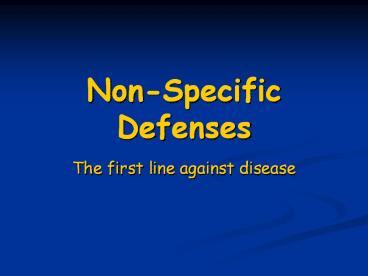Non-Specific Defenses - PowerPoint PPT Presentation
1 / 25
Title:
Non-Specific Defenses
Description:
(Crisis) The Complement System Serum proteins activated in a cascade. Effects of Complement Activation Opsonization or immune adherence: ... – PowerPoint PPT presentation
Number of Views:26
Avg rating:3.0/5.0
Title: Non-Specific Defenses
1
Non-Specific Defenses
- The first line against disease
2
Nonspecific Defenses of the Host
- Susceptibility Lack of resistance to a
disease - Resistance Ability to ward off disease
- Nonspecific resistance Defenses against any
pathogen - Specific resistance Immunity, resistance
to a specific pathogen
3
Host Defenses
Figure 16.1
4
Mechanical Factors
- Skin
- Epidermis consists of tightly packed cells with
Keratin, a protective protein - Mucous membranes
- Ciliary escalator
- Microbes trapped in mucus are transported away
from the lungs - Lacrimal apparatus
- Washes eye
- Saliva
- Washes microbes off
- Urine
- Flows out
- Vaginal secretions
- Flow out
5
Chemical Factors
- Fungistatic fatty acid in sebum
- Low pH (3-5) of skin
- Lysozyme in perspiration, tears, saliva, and
tissue fluids - Low pH (1.2-3.0) of gastric juice
- Transferrins in blood find iron
- NO inhibits ATP production
6
Normal Microbiota
- Microbial antagonism/competitive exclusion
- Normal microbiota compete with pathogens.
7
Formed Elements In Blood
Table 16.1
8
Differential White Cell Count
- Percentage of each type of white cell in a sample
of 100 white blood cells
9
White Blood Cells
- Neutrophils Phagocytic
- Basophils Produce histamine
- Eosinophils Toxic to parasites, some
phagocytosis - Monocytes Phagocytic as mature macrophages
- Fixed macrophages in lungs, liver, bronchi
- Wandering macrophages roam tissues
- Lymphocytes Involved in specific immunity
10
Phagocytosis
Figure 16.8a
11
Microbial Evasion of Phagocytosis
12
Inflammation
- Redness
- Pain
- Heat
- Swelling (edema)
- Acute-phase proteins activated (complement,
cytokine, kinins) - Vasodilation (histamine, kinins, prostaglandins,
leukotrienes) - Margination and emigration of WBCs
- Tissue repair
13
Chemicals Released by Damaged Cells
14
Inflammation
Figure 16.9a, b
15
Inflammation
Figure 16.9c, d
16
Fever Abnormally High Body Temperature
- Hypothalamus normally set at 37C
- Gram-negative endotoxin cause phagocytes to
release interleukin 1 - Hypothalamus releases prostaglandins that reset
the hypothalamus to a high temperature - Body increases rate of metabolism and shivering
to raise temperature - When IL-1 is eliminated, body temperature falls.
(Crisis)
17
The Complement System
- Serum proteins activated in a cascade.
Figure 16.10
18
Effects of Complement Activation
- Opsonization or immune adherence enhanced
phagocytosis - Membrane attack complex cytolysis
- Attract phagocytes
Figure 16.11
19
Effects of Complement Activation
Figure 16.12
20
Classical Pathway
Figure 16.13
21
Alternative Pathway
Figure 16.14
22
Lectin Pathway
Figure 16.15
23
Some bacteria evade complement
- Capsules prevent C activation
- Surface lipid-carbohydrates prevent MAC formation
- Enzymatic digestion of C5a
24
Interferons (IFNs)
- Alpha IFN Beta IFN
- Cause cells to produce antiviral proteins that
inhibit viral replication - Gamma IFN
- Causes neutrophils and macrophages to
phagocytize bacteria
25
Interferons (IFNs)
New viruses released by the virus-infected host
cell infect neighboring host cells.
5
2
The infecting virus replicates into new viruses.
AVPs degrade viral m-RNA and inhibit protein
synthesis and thus interfere with viral
replication.
6
Viral RNA from an infecting virus enters the cell.
1
The infecting virus also induces the host cell to
produce interferon on RNA (IFN-mRNA), which is
translated into alpha and beta interferons.
3
Interferons released by the virus-infected host
cell bind to plasma membrane or nuclear membrane
receptors on uninfected neighboring host cells,
inducing them to synthesize antiviral proteins
(AVPs). These include oligoadenylate synthetase,
and protein kinase.
4
Figure 16.16































